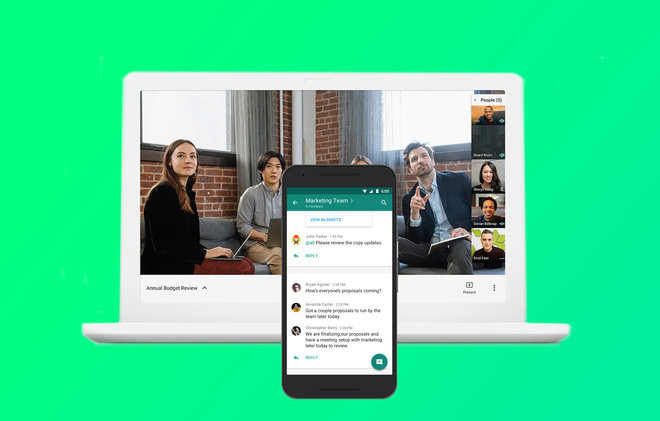
Video conferencing software and apps are an essential means of communication for all sorts of people and businesses.
Whether you’re in a long-distance relationship, taking an online class, or working from home, you need a way to connect over video conferencing with others. Products like Zoom, Microsoft Teams, and Google Meet (formerly Hangouts Meet) are among the most popular video conferencing solutions.
To help you decide which is best, we’ve pitted these three apps against each other and compared what they have to offer.

Zoom
Zoom is a video conferencing service you can use to virtually meet with others – either by video or audio-only or both, all while conducting live chats. And it lets you record those sessions to view later. It was originally a niche service used primarily by enterprise clients (over half of Fortune 500 companies reportedly used Zoom in 2019). Now, however, Zoom has over 300 million daily users.
This rapid growth has caused some slight scaling issues – mostly in the form of Zoom bombing, which is what happens when participants join a Zoom Meeting uninvited and broadcast NSFW content. Zoom recently issued a big 5.0 update to help curb this security issue, though.
Features
When people are talking about Zoom, you’ll usually hear the following phrases: Zoom Meeting and Zoom Room. Zoom Meeting refers to a video conferencing meeting that’s hosted using Zoom. You can join these meetings via a webcam or phone. Meanwhile, a Zoom Room is the physical hardware setup that enables companies to schedule and launch Zoom Meetings from their conference rooms.
Besides its low cost to use, what makes Zoom so attractive is that it is dead simple, and you can easily access it from your laptop or mobile devices. Its key features include the ability to host unlimited one-on-one meetings even with the free plan, meet with large groups, share your screen or audio, and even change your background to a custom virtual image – no green screen required.
Zoom has be the best options for screen sharing and participant control in our opinion, but has faced criticism over some security issues.
Supported devices
The desktop app is available for Windows and macOS, while the mobile app is available for Android and iOS, or it can run in a browser.
Pricing
Zoom’s free tier allows unlimited one-on-one meetings but limits group sessions to 40 minutes and 100 participants. Paid plans start at $15 per month per host. Zoom Rooms require an additional subscription on top of a subscription and is more ideal solution for larger companies.

Microsoft Teams
Microsoft Teams is a chat-based workspace in Microsoft 365 (formerly Office 365). It is intended for anyone who uses M365 on a regular basis. However, if your company or organisation is a Google G Suite user, then it’s really not going to be as appealing, and you’re probably better off with Slack, an independent alternative. In fact, Teams is more of a Slack rival than a Zoom rival – focusing on chats more than video.
But since Teams has integrated video calling functionality, it’s definitely worth considering. It recently hit 44 million daily users and is reportedly used by hundreds of thousands of businesses, organisations, schools, and colleges.
Features
Teams is integrated with all the Microsoft apps, including Skype and the traditional Office apps like Outlook. It combines business VoIP, collaboration, and video features into a single app. It’s mostly about threaded, persistent chats which you can then search later – so you can keep track of everything without having to use email, which everyone agrees is not an ideal tool for collaboration.
Teams is designed to get people to work more effectively together while making use of the integration of Microsoft 365 apps. You can do things like easily set up a meeting with calendars, create and share content, call team members easily, and more. In terms of video conferencing, it has the ability to host calls with up to 250 members. It also offers screen sharing and call recording.
You can see up to nine participants on a call simultaneously, and Teams can even provide transcripts of a meeting shortly after the meeting.
Supported devices
Microsoft Teams is compatible with Windows, macOS, Android, iOS and it’s also available on the web – just like other Microsoft 365 apps.
Pricing
Microsoft Teams is included with all Microsoft 365 plans (which start at $5 a user per month), but there is a freemium version of the service that includes support for up to 300 people. If you’re on the free tier, Microsoft said you’ll get unlimited chat messages and search. You also get key features like 10,000 searchable messages, 10 app integrations, 5GB of file storage, and 1:1 video chats.

Google Meet
Google recently rebranded Hangouts Meet to simply Google Meet. It’s a video conferencing solution built into Gmail, YouTube, and Google Voice, plus there are apps for iOS, Android, and it will run through most browsers. It’s essentially a useful and cost-effective platform for small businesses as well as enterprise customers. It has a very light, fast interface that enables you to easily manage up to 250-person meetings.
The video-conferencing service serves about 100 million users every day, including G Suite enterprise and corporate clients, although Google has made Meet available to all Google account holders. That will mean individuals can host 100 participant meetings for up to 24 hours without a G Suite subscription. That arrangement will be in place until 30 September 2020.
Features
Google Meet can handle up to 250 participants per call, live streaming for up to 100,000 viewers within a domain, and can record meetings on Google Drive for later broadcast, for paying G Suite subscribers. As Google Meet is coming to all account holders, that’s all you’ll need to start a basic meeting for up to 100 participants, with the normal 60 minute time limit waived, so you can host 24 hour meetings.
G Suite organisers can set up calls via Google Calendar, meeting link URLs or codes, dial-in by phone numbers, and through dedicated Google Meet hardware like Chromebox and Chromebase. For G Suite Enterprise customers, each meeting has a dedicated dial-in phone number.
Google Meet also recently updated to include a Zoom-like gallery view. While you were only able to see four people at a time before, Meet has ushered in a new tiled layout, allowing you to see 16 call participants at once. It will allow screen sharing in various forms and Google is keep to push the security of Meet thanks to sitting on Google Cloud infrastructure. Google Meet doesn’t have all the screen sharing options that Zoom offers.
Supported devices
Google Meet is available as an Android and iOS mobile app. You can also access Meet via Chrome, Mozilla, Microsoft, or Safari web browsers.
Pricing
G Suite plans include access to Google Meet and start at $6 a user per month for the Basic tier (includes G Suite apps and 30GB of cloud storage). Anyone with a Google account will be able to access Google Meet free, with access rolling out in May 2020.

Which is best for you?
Here’s your decision tree: are you a regular, everyday consumer looking to keep in touch with friends and family? Then use Zoom or Google Meet – especially now the latter is now freely available. Do you run a small group? These are probably your best options too.
Are you a G Suite user? Definitely use Google Meet.
Are you a Microsoft 365 user? Go with Microsoft Teams.
Are you a business or school? You’re probably either using G Suite or 365, so use whatever video conferencing app is included with your plan – but if not, there’s free access to Zoom and Google Meet to support you.
Honestly, Zoom and Google Meet are the quickest and most straightforward ways to start video calls using calendar links, meeting URLs, and phone dial-in numbers. You don’t even need to create an account with Zoom, though Meet requires at least a free Google account, which Google says is a security feature. Microsoft Teams, on the other hand, really shines when a team needs to jump on a video call from a chat message thread.
If you really want us to recommend one service to try, go with Zoom. It’s what everyone is using at the moment, and the company has been doubling down on its security efforts, even rolling out a major 5.0 update that groups key settings under a new security icon in the menu bar. It also betters Google Meet when it comes to managing larger groups and offers better screen sharing options and controls.
